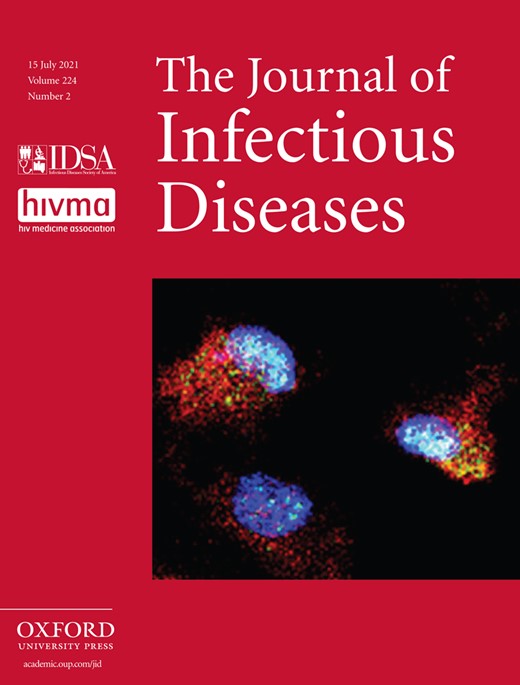-
PDF
- Split View
-
Views
-
Cite
Cite
Alicia N M Kraay, Reply to Park et al, The Journal of Infectious Diseases, Volume 224, Issue 2, 15 July 2021, Pages 371–372, https://doi.org/10.1093/infdis/jiab246
Close - Share Icon Share
To the Editor—I read with great interest the recent data provided by Dr Park et al regarding on the impact of nonpharmaceutical interventions (NPIs) for severe acute respiratory syndrome coronavirus 2 (SARS-CoV-2) on incidence of gastrointestinal illness in South Korea [1]. The authors note that the incidence of norovirus and rotavirus was lower in 2020 compared with 2015–2019, whereas the incidence of Salmonella spp., Campylobacter spp., and Clostridium perfringens was similar or higher than prior years.
Although the qualitative findings are interesting, it is important to note that firm statistical conclusions cannot be drawn because statistical significance and confidence intervals are not reported, which makes it difficult to determine if the reported association is within the bounds of what might be expected based on natural year-to-year variation and secular trends in incidence. For example, despite the positive point estimate (suggestive of increased risk under social distancing), incidence for Campylobacter spp. has been gradually increasing over time in many countries [2], and the authors’ results suggest this may also be the case in South Korea, with 2020 incidence being similar to that observed in 2019. Qualitatively, incidence of C. perfringens also appears to be increasing over time in South Korea. Thus, the positive point estimate for these pathogens might be more reflective of secular trends than being causally related to NPIs implemented in response to SARS-CoV-2. In contrast, after March 2020, the incidence of rotavirus appears to be far below the reported incidence for any previously reported year. Norovirus incidence appears to be lower than prior years, but there is 1 year that is similar to the patterns observed in 2020.
Additionally, the authors appear to average their reported effect estimates of the entire 2020 calendar year, even though widespread NPIs did not begin until March. This approach could have biased the overall effect estimates towards the null. This potential bias is particularly pertinent for winter-time pathogens like norovirus and rotavirus, for which annual incidence is usually highest early in the calendar year in temperate climates like South Korea [3, 4]. Including these months in the overall estimate for 2020 would tend to dilute the true impact of NPIs, biasing the overall effect estimate toward the null. I note that 2020 appeared to be an initially severe norovirus year, with incidence not beginning to drop until around the time that social distancing began around week 9. In contrast, rotavirus activity appeared to be lower than usual, even in January and February.
Despite these challenges, the reported data provide interesting insight into descriptive differences in incidence between pathogens that may relate to their transmission dynamics. Generally, social distancing would be expected to have the greatest impact on direct transmission pathways. The authors acknowledge that all 3 foodborne pathogens exhibit similar or higher risk compared with prior years, whereas norovirus and rotavirus, which are efficiently transmitted from person to person, exhibited the opposite pattern. Among the 3 foodborne pathogens, it is interesting to note that Campylobacter and C. perfringens do not commonly spread from person to person and require ingestion of contaminated food to spread [2, 5], and would therefore be less likely to exhibit a decline in incidence. In contrast, Salmonella can be transmitted both person to person and through contaminated food [6], which may explain the smaller point estimate for this pathogen.
We are only just beginning to understand the impact of the coronavirus disease 2019 (COVID-19) pandemic on infectious disease transmission. Future data from various settings regarding the impact of NPIs on incidence, including for nonrespiratory pathogens, are important as we seek to understand the far-reaching impact of these interventions. As NPIs begin to relax, it will also be instructive to see how reduced circulation interplays with declining population immunity to shape outbreak dynamics going forward [7].
Notes
Financial support. This work was supported by National Institutes of Health, National Institute of General Medical Sciences (grant numbers R01GM124280 and R01GM12480-03S1); and National Science Foundation (grant number 2032084).
Potential conflicts of interest. The author certifies no potential conflicts of interest. The author has submitted the ICMJE Form for Disclosure of Potential Conflicts of Interest. Conflicts that the editors consider relevant to the content of the manuscript have been disclosed.




